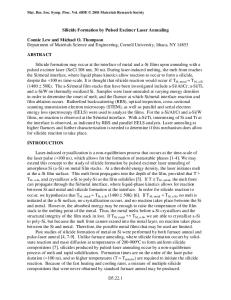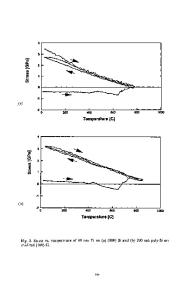Noble metal silicide formation in metal/Si structures during oxygen annealing: Implications for perovskite-based memory
- PDF / 226,475 Bytes
- 7 Pages / 612 x 792 pts (letter) Page_size
- 0 Downloads / 323 Views
MATERIALS RESEARCH
Welcome
Comments
Help
Noble metal silicide formation in metalyySi structures during oxygen annealing: Implications for perovskite-based memory devices K. L. Saenger, A. Grill, and C. Cabral, Jr. IBM Research Division, T. J. Watson Research Center, Yorktown Heights, New York 10598 (Received 17 March 1997; accepted 26 June 1997)
This paper investigates the potentially undesirable noble metal silicide formation reactions that may occur in noble metal electrodes deposited directly on silicon without an intervening diffusion barrier. Metal (90 –100 nm)ySi structures of PtySi, RhySi, IrySi, and IryTiySi were annealed in oxygen or nitrogen ambients at temperatures of 640–700 ±C. Metalysilicon reactions and phase formation were studied by Rutherford Backscattering Spectroscopy, x-ray diffraction, and electrical resistance measurements. While complete silicidation was observed in the RhySi, PtySi, and IrySi samples after 640 ±Cy6 min anneals in nitrogen, some Pt and most of the Ir remained after equivalent anneals in oxygen. More detailed studies of the IrySi samples indicated that some Ir is left unsilicided even after a 700 ±Cy6 min anneal in O2 , and that the iridium silicide formed is the semiconducting IrSi1.75 . The formation of this silicide can be delayed, but not prevented, with the use of a 5 nm Ti adhesion layer between the Ir and Si.
I. INTRODUCTION
Noble metals are candidate electrode materials for semiconductor memory devices incorporating ferroelectric or high-epsilon dielectric materials, such as lead lanthanum titanate, barium strontium titanate, etc., in part because noble metals do not form insulating metal oxides during the oxidizing conditions of dielectric deposition.1 In most direct-contact device geometries, noble metal electrodes contact silicon either directly, or through a conductive diffusion barrier. This paper investigates the potentially undesirable noble metal silicide formation reactions in metalySi structures not containing a diffusion barrier layer. While some silicidation may be beneficial, leading, for example, to improved electrodeySi adhesion and/or reduced contact resistance, completely silicided noble metal electrodes are susceptible to oxidation with attendant formation of a surface layer of low-epsilon SiO2 . An additional concern is the resistivity of the formed silicide, which will depend on its stoichiometry and crystalline phase. The silicides of Ir include Ir4 Si5 and Ir3 Si4 with room temperature resistivities in the range2 60–70 mV –cm, IrSi with a resistivity2 of about 500 mV –cm, and IrSi1.75 (believed to be the same silicide described as Ir3 Si5 in Refs. 2 and 3) which is reported to be semiconducting with a resistivity4 in excess of 1 V –cm. A very high resistivity silicide, such as IrSi1.75 , at the noble metalySi interface would clearly be undesirable. Noble metal silicide formation in metalySi structures has been extensively studied, but most previous work pertains to silicide formation during annealing in 462
http://journals.cambridge.org
Data Loading...










